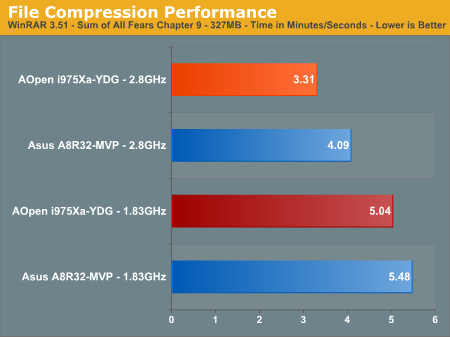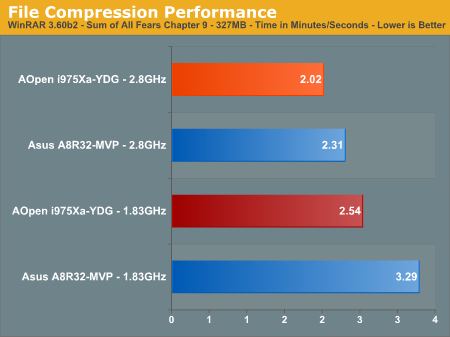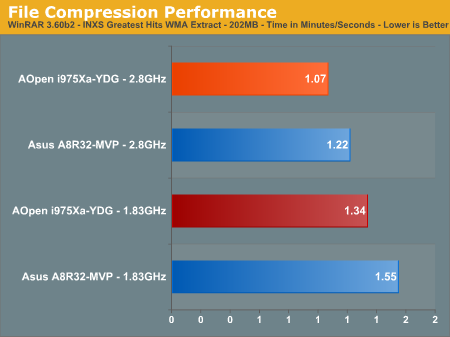Intel Core Duo: AOpen i975Xa-YDG to the Rescue
by Gary Key on May 4, 2006 8:00 AM EST- Posted in
- Motherboards
File Compression Performance
In order to save space on our hard drives and ensure we had another CPU crunching utility, we will be reporting our file compression results with two different versions of WinRAR. Our first file compression test utilizes WinRAR 3.51 to compress our Sum of All Fears Chapter 9 test file and our INXS Greatest Hits wma extraction tracks. All default settings in WinRAR are utilized along with our hard drive being defragmented before each test.

The Intel platform basically zips away from the AMD platform in our tests. File compression is a very CPU intensive application and also stresses the memory subsystem heavily. The added cache of Core Duo certainly helps in this particular test. The other interesting result is that our performance results scaled almost 1:1 with the increase in CPU speed, again indicative of a benchmark that makes good use of CPU cache. As an example, our Intel system has a 53% increase in CPU speed while the file compression numbers improved 52% in the Sum of All Fears benchmark and 59% in our INXS Greatest Hits compression test.
Our second series of file compression tests utilizes WinRAR 3.60b2 to compress the same files as before. All default settings are once again utilized in WinRAR along with our hard drive being defragmented before each test. This particular version of WinRAR fully supports multi-threading operations and should be of particular interest for those users with dual core or multi-processor systems.


The program update to WinRAR produces stunning results as we see drops of up to 66% in our Sum of All Fears results and 48% in the INXS Greatest Hits benchmark due to the multi-threading support. We also see the gap close up to 11% between the two platforms indicating our AMD Opteron has improved performance under this application. Basically, the multi-threading support in this version of WinRAR has negated the need for an additional 1GHz of CPU speed.










81 Comments
View All Comments
Gary Key - Friday, May 5, 2006 - link
Sorry, being a selfish s.o.b. with this drive, actually I am testing two of them for an upcoming article. :)
sabrewulf - Thursday, May 4, 2006 - link
I haven't been following the development of Conroe too closely, but isn't this chip essentially performing like Conroe will? Or am I missing something?Some of the tests were impressive, but the gaming tests were certainly not "20-40%" improvement over AMD like everyone is wishing.
MrKaz - Thursday, May 4, 2006 - link
And "will" never be.Don’t forget Intel was using:
- Some special ATI driver.
- Crossfire setup (maybe modified),
20%~40% that you will never get, unless you have such kind of configuration.
On non SLI/Crossfire configuration will never be higher than 5%, 10% improvement...
And thanks that a lot to the 4MB cache, and minor processor (P3 redesign) changes.
Don’t forget that the Intel dual core with 4MB shared cache can act as one BIG single core processor with 4MB cache and the second core with 0MB of cache for the extra “stupid” calc...
IntelUser2000 - Thursday, May 4, 2006 - link
LOL. I always doubt that people can be such a dumb fanboy even I see them over and over again in time.
How do you explain Xtremsystems benchmark, and all the architectural advantages?? Did Netburst's poor showing really blind you??
MrKaz - Friday, May 5, 2006 - link
Fun boy me?It's you who calls him self by the stupid nick name Inteluser2000.
Some time there are complete morons here and you are one of them.
ME the "fan boy" has to "defend" Intel, a thing that you with your little brain can’t do.
Read my reply to your fan boy friends, there you will find why conroe will be good, and it's not because it's Intel.... dumb moron....
redbone75 - Thursday, May 4, 2006 - link
I don't think it was a "special" driver per se, if I recall the driver had some changes made in order to recognize Conroe.
I just love how a lot of people refer to Conroe as a P3 redesign as if it's something so bad. No, it's not a P3 redesign, there are elements of what made the P3 so successful incorporated into the chip, but that's not what makes the chip so awesome. Also, so what if it is ultimately just a "P3 redesign" as you put it? You use what works, and obviously this works. Hey, the K7 core was pretty good, and K8 is so well designed that AMD can ride it for a few more years.
MrKaz - Friday, May 5, 2006 - link
"in order to recognize Conroe"Why they need to recognize Conroe?
-Would work?
-Did work but with inferior performance?
-Special optimizations?
-New instruction set (SSE4) support for improved performance?
Questar - Thursday, May 4, 2006 - link
Wow, some fanboys are still in denial.This is an interim MOBILE chip that just put the smack down on an Opteron. What's going to happen when the real thing comes out?
MrKaz - Friday, May 5, 2006 - link
When the real thing come out? That’s easy:Core duo plus:
- 2MB cache (+5%~10%)
- 2X FSB (+4%~8%)
- 800Mhz DDR2 (3%~6%)
- x64 support (0%)
- Higher clock speed 2.1Ghz to 3.3Ghz (anyone can say 50% performance increase?)
I’m not a fan boy, it’s you Intel stupid morons that can even read and make some thought why should Conroe be faster than AMD Athlon 64….
Go back and reread the article about:
Intel Core versus AMD's K8 architecture
Don’t expect conroe be very different from core duo... I’m not saying that’s bad…
Questar - Friday, May 5, 2006 - link
You forgot a couple of things:Addidtional ALU Unit
Twice the SSE performace
Better code reordering
Larger reservation station
New micro-ops